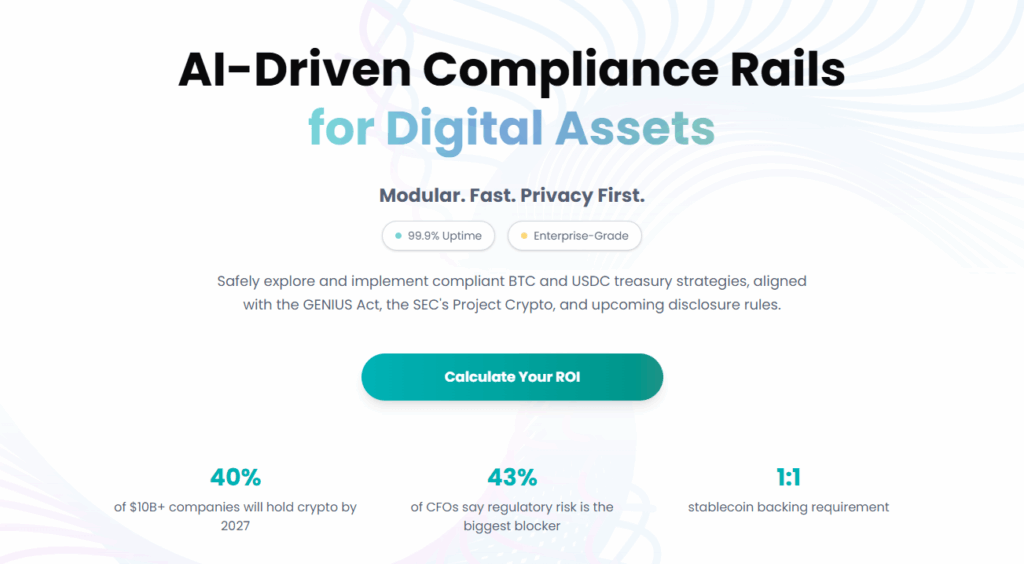
For high-frequency compliance scenarios in digital assets and fintech, ComplyGen unifies “marketing content review, KYC/KYB, AML, and audit reporting” into an AI-driven workflow that helps institutions achieve “fast review, traceability, and accountability” after new rules take effect. Its products follow the GENIUS Act for stablecoins and the SEC’s “Project Crypto,” emphasizing modularity, privacy-first design, and enterprise-grade readiness. This Innovation and Tech article analyzes the project’s positioning, technical architecture, core products, and ecosystem partnerships.
Summary: ComplyGen is an AI compliance platform for digital assets that covers marketing compliance and KYC/KYB/AML processes, and provides audit-ready reports. In line with the GENIUS Act and new SEC rules, it has begun pilots and paid deployments with financial institutions.
What is ComplyGen?
ComplyGen positions itself as “AI-Driven Compliance Rails.” The platform provides components such as “identity verification, sanctions screening, compliance models, board policies, audit reports, and governance dashboards,” serving Bitcoin and stablecoin treasuries, wallets and stablecoin issuance, as well as compliance disclosures (10-K/10-Q narrative templates, on-chain compliance logs, and audit trails). Its selling points are 99.9% availability, enterprise-grade standards, and privacy-first design, fitting the goal of “compliance first, then expansion” for financial institutions and public companies.
Core Problems ComplyGen Solves
- Compliance review is slow and fragmented: marketing collateral, onboarding, due diligence, and funds review are disjointed.
- New rules impose rigid requirements: 1:1 reserves for stablecoins, on-chain KYC, the Travel Rule, and disclosure obligations.
- Internal control and external audit pressure: an automated, “traceable and provable” evidence chain is needed.
ComplyGen connects “content → identity → transactions → disclosures” via a unified rule engine and audit logs, shortening go-live timelines for public companies and financial institutions.
Technical Architecture and Capabilities
ComplyGen’s frontend and orchestration layer integrate capabilities for “KYB/KYC, AML/sanctions, compliance rules, board policies, audit reports, and governance dashboards,” while the backend executes AI and rules in parallel to produce auditable on-chain/off-chain evidence. Its website outlines a three-step delivery path: “identity-verification wallet infrastructure,” “legal and regulatory review,” and “audit-ready documentation.”
Rules Engine + LLM/RAG
Compliance models convert regulations and internal policies into “machine-readable rules,” context-matching marketing copy and page components. A typical approach embeds statutes into retrieval-augmented generation (RAG) and outputs modification suggestions with “explainable prompts and matched clauses.” Industry research shows AI can greatly shorten review cycles while maintaining consistency, freeing compliance teams to handle higher-risk items.
KYC/KYB and AML Workflows
ComplyGen links onboarding and enterprise verification (KYB/KYC), sanctions lists, and adverse media (AML/Sanctions) through “identity → risk control → reporting,” bringing “submission—matching—exception handling—review—archiving” into a unified queue. The homepage explicitly lists “KYB/KYC, AML/sanctions, compliance rules, and audit reports” as handled on the same platform.
Audit and Disclosure Automation
ComplyGen offers 10-K/10-Q narrative templates, proofs of ownership, on-chain transaction logs, and SEC-ready audit trails to meet record-keeping needs for regulators and external auditors, emphasizing “export-to-deliver.”
Privacy and AI Guardrails
In AI compliance systems, organizations deploy policy guardrails to constrain model behavior and data boundaries, reducing hallucinations and compliance drift; consultancies and research view this as a prerequisite for scaled deployments. ComplyGen’s “privacy-first, enterprise-grade” positioning aligns with this trend.
Regulatory Environment and Market Demand
In July 2025, the GENIUS Act took effect, requiring stablecoins to maintain 1:1 reserves in highly liquid assets, imposing BSA AML obligations, limiting interest, and setting disclosure and audit requirements. The SEC simultaneously announced “Project Crypto,” seeking to push securities-rule “on-chain-ification,” raising the bar for disclosure and compliance automation. According to resources.fenergo data, global financial regulatory fines totaled about $4.6B in 2024, with North America accounting for as much as 95%, creating strong pressure from compliance spend and fines. ComplyGen aims to scale, automate, and audit these “mandatory actions.”
Core Products: How They Fit Daily Workflows
Marketing Compliance Review
Submit collateral, landing pages, and social copy for checks; the system automatically compares against clause lists and outputs “hits—edit suggestions—risk levels,” reducing enforcement risks from misleading promotions, return promises, or insufficient disclosures. Industry articles have validated that this approach can be embedded in compliance-team review.
KYC/KYB Orchestration
Connect identity sources and corporate registries, configure “high-risk countries/industries” and “secondary verification,” auto-generate traces and manage exceptions; the “identity-verification wallet infrastructure” binds entities to on-chain addresses.
AML/Sanctions Screening
Unify list hits, transaction-pattern detection, and manual-review queues, supporting “hit explanations + evidence retention.”
Travel Rule/Disclosures
Generate external disclosures and on-chain transaction logs, paired with audit exports to reduce audit friction and deferral costs.
Ecosystem Partnerships and Pilots
ComplyGen states it offers an “identity verification + audit-ready” delivery bundle for corporate treasuries (BTC/USDC), stablecoin issuers, and wallets, plus advisory-grade “legal/regulatory reviews.” Its resources pages and microsites (e.g., GENIUS Act 101) present client-facing guidance and testimonials for presales education and pilot rollouts—a model common in regtech adoption by banks and fintechs.
Recent Progress and External Drivers
GENIUS Act in Effect
Stablecoin issuance is brought under the BSA, requiring 1:1 reserves and strict disclosures; many law firms have published interpretations with actionable provisions for implementation.
SEC “Project Crypto”
Public remarks and client alerts suggest disclosure frameworks and registration paths will be updated, making “audit-ready” and “machine-readable” compliance materials mainstream deliverables.
Fine Trends
Both total fines and average fines rose in 2024; enforcement continues around “marketing materials, record retention, and unauthorized communication tools,” reinforcing the need for automated review and traceable evidence chains.
FAQ
Q1: Does ComplyGen cover marketing content review?
A: The platform provides “compliance rules + audit reports” and policy templates, suitable for rule-checking marketing materials and pages; industry research also confirms AI can significantly accelerate content-compliance review.
Q2: What KYC/KYB/AML capabilities does ComplyGen have?
A: The homepage lists KYB/KYC, AML/sanctions, compliance rules, board policies, audit reports, and governance dashboards handled on one platform, emphasizing “identity-verification wallet infrastructure.”
Q3: Why are the GENIUS Act and SEC “Project Crypto” important?
A: The GENIUS Act mandates 1:1 reserves and BSA AML obligations for stablecoins; the SEC initiative advances “on-chain disclosures.” Together they raise the bar for “audit-ready automation.”
Q4: Is there industry fine data supporting automation investments?
A: Research shows global financial fines were about $4.6B in 2024, with North America at 95%; investing in automation can reduce mis/under-review and repetitive work.
Q5: Who are ComplyGen’s typical customers?
A: Public-company CFO/legal/compliance teams, stablecoin issuers and wallet/payment firms, and corporate-treasury clients needing “identity-bound wallets + audit-ready” solutions.
Q6: How are rollout timelines and evidence retention ensured?
A: The website provides a “three-step delivery” (wallet and process solution, legal/regulatory review, audit-ready documents) and offers 10-K/10-Q templates and on-chain log exports.
Key Points
Compliance automation backbone: ComplyGen connects marketing compliance with KYC/KYB/AML, disclosures, and audits to build a “rules—execution—traceability” loop.
Clear external drivers: The GENIUS Act and SEC “Project Crypto” raise standards for 1:1 reserves, on-chain KYC, and disclosures—making automation a necessity.
Business recommendation: Advance with “localized rule packs + audit evidence chains + wallet identity binding,” and measure compliance ROI quarterly.






